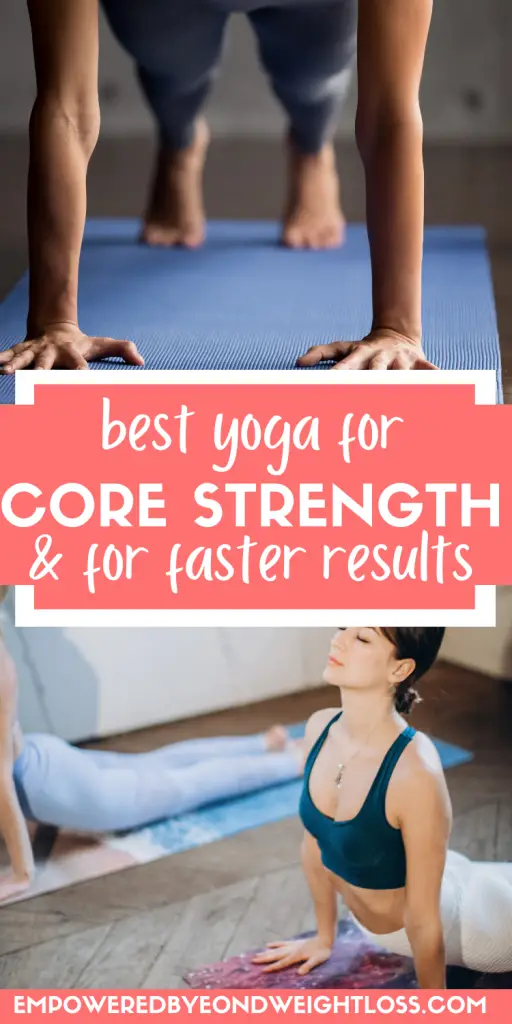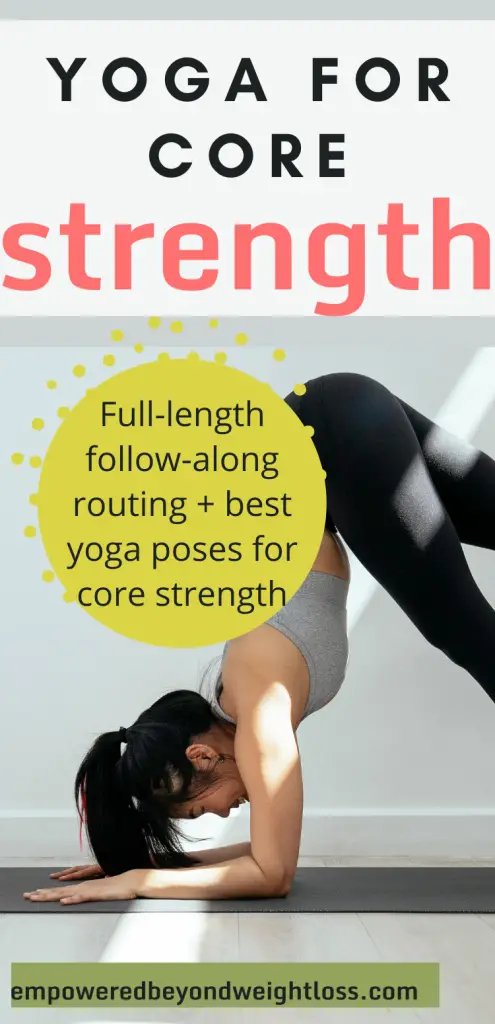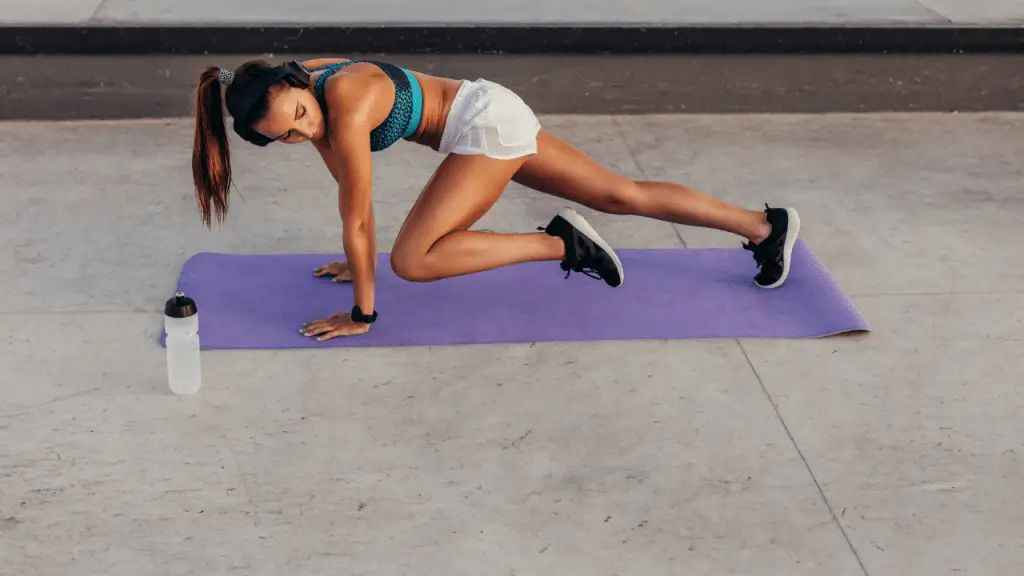Yoga is overall an excellent exercise for a strong core. The best yoga for a strong core is all about finding yoga poses and routines that work for you because they are challenging enough but not too challenging that you hate or can’t do.
Best Yoga for Core Strength Follow Along Routine
Here’s your core strength video for this week:
What Is a Strong Core and Why Is It Important?
A strong core refers to the body’s abdominal, lower back, and pelvic muscles. These muscles work together to provide stability and support to the spine, pelvis, and trunk. A strong core is essential for several reasons:
- Posture: A strong core helps maintain good posture by supporting the spine and preventing slouching or hunching. Proper posture can reduce the risk of musculoskeletal problems and back pain.
- Balance and Stability: Core muscles are essential for balance and stability. They help you maintain equilibrium when standing, walking, or performing various activities, reducing the risk of falls and injuries.
- Functional Movements: A strong core is crucial for performing everyday movements such as bending, twisting, lifting, and reaching. It provides the foundation for these movements and helps prevent strain or injury.
- Sports and Physical Activities: In sports and physical activities, a strong core is often essential for generating power, agility, and speed. It can improve athletic performance and reduce the risk of sports-related injuries.
- Back Health: Core strength can help alleviate or prevent lower back pain. Weak core muscles can lead to poor spinal alignment and increased stress on the lower back, which may result in discomfort or injury.
- Breathing: The diaphragm, a muscle involved in breathing, is also part of the core. A strong core can aid in efficient breathing, which is important for overall health and performance.
- Digestion and Organ Support: Core muscles provide support to the abdominal organs. A strong core can aid in proper digestion and organ function.
To build a strong core, you can engage in exercises specifically targeting these muscles, such as planks, leg raises, crunches, and yoga poses like the boat pose. Remember that a strong core is not just about having visible abdominal muscles (often called a “six-pack”). It’s about having a balanced and functional set of muscles that provide support and stability for your body.

10 Yoga Poses for a Strong Core
1. Boat Pose (Navasana)
Boat Pose is an effective yoga pose for strengthening the core muscles. In this pose, one sits on the mat, balances on the sitting bones, and lifts the legs and upper body off the ground, forming a V shape with the body. This posture engages the abdominal muscles, lower back, and hip flexors, helping to improve core strength, stability, and balance. Regular practice of Boat Pose can contribute to a stronger core and enhanced physical fitness.
The boat pose is one of my favorites! I created a core routine inspired by the boat pose: Core-Strengthening Yoga Exercises: 10-Minute Routine!.
2. Plank Pose (Phalakasana)
Plank pose is an effective yoga posture that promotes core strength and stability. By balancing on the hands and toes while maintaining a straight line from head to heels, plank pose engages the abdominal muscles, lower back, and shoulders. It is a yoga pose for core strength “par excellence,” I include all its variations here: side plank, forearm plank, plank with hip dips, turbo plank, etc.
Regular practice of plank pose can improve overall core strength, enhance posture, and support spinal alignment.
3. Pendant Pose (Lolasana)
The pendant pose is excellent for building a strong core in yoga practice. By engaging the abdominal muscles and the lower back, this pose helps strengthen the core while improving balance and stability. Regular practice of pendant pose can lead to increased core strength, enhanced posture, and improved overall body control.
Furthermore, pendant pose improves your compression strength, which I find to be still really difficult after three years of practicing yoga.
A core compression exercise is a type of physical exercise that focuses on strengthening the muscles of the core, particularly the deep stabilizing muscles. These exercises typically involve the contraction or compression of the abdominal and lower back muscles to improve core stability, posture, and overall strength.
Core compression exercises often target muscles such as:
- Transverse abdominis: This deep abdominal muscle acts like a corset around your abdomen and helps stabilize your spine.
- Pelvic floor muscles: These muscles support the organs in your pelvic region and play a crucial role in core stability.
- Multifidus: A group of small muscles that run along the spine, providing stability and support.
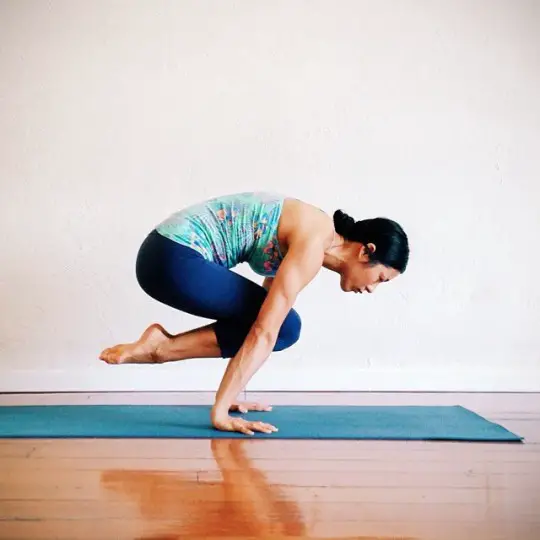
4. Dolphin Pose (Ardha Pincha Mayurasana)
This pose engages the abdominal muscles, lower back, and shoulders, promoting stability and balance. By regularly practicing dolphin pose, individuals can develop a strong core, leading to improved posture, enhanced athletic performance, and reduced risk of back pain. Plus, it will improve your shoulder and hamstring flexibility.
I usually include dolphin pose in my strength and flexibility routines because it is a whole-body, multi-purpose pose. Check out 5 Effective Yoga Poses for Strength and Flexibility for more.
5. Warrior 3 (Virabhadrasana III)
This standing balance pose requires a strong engagement of the abdominal muscles, lower back, and hip stabilizers to maintain proper alignment. By regularly practicing Warrior 3, individuals can improve their core strength, stability, and balance, leading to better posture and overall body control.
Furthermore, I love including Warrior 3 transitions for increased mobility and leg strength. For example, try Yoga for Glute Strength: Yoga Poses to Lift Your Booty! and Functional Mobility Workout Inspired By Yoga.
6. Crow Pose (Kakasana)
Crow pose is an excellent yoga practice for building a strong core. By engaging the abdominal muscles, crow pose challenges the stability and balance of the body. This pose requires the practitioner to support their body weight on their hands while keeping the core engaged, strengthening the abdominal muscles, and improving overall core strength. Incorporating crow pose into a regular yoga routine can help develop a solid core foundation and enhance body control and coordination.
Needing help with your crow pose? I created a Step-By-Step Crow Pose Progression for Beginners.
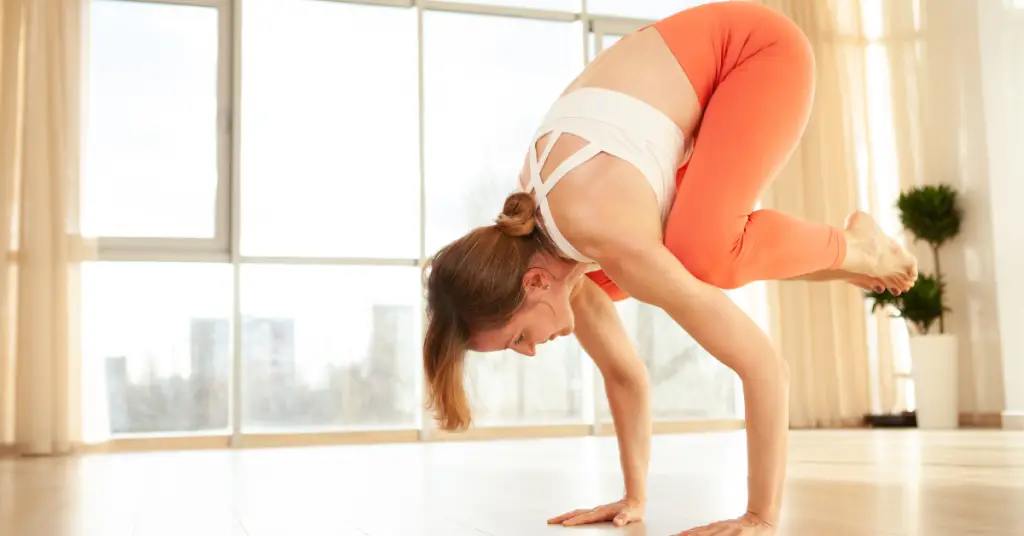
7. Upward Plank (Purvottanasana)
Upward Facing Plank, or Purvottanasana, is an excellent yoga pose for strengthening the core. In this pose, the body forms a straight line from the heels to the crown of the head, engaging the abdominal muscles, lower back, and glutes. It activates and tones the entire core area, promoting stability, balance, and overall strength. Regular practice of Upward Facing Plank can contribute to a strong and resilient core, making it a valuable addition to any core-strengthening yoga routine.
8. Chaturanga
Chaturanga is another perfect example of a yoga pose that engages your whole body. I think this is why I fell in love with yoga! Yoga is a powerful exercise that requires strength, flexibility, and mindfulness.
Chaturanga, the Four-Limbed Staff Pose, is considered one of the best yoga poses for developing a strong core. This challenging posture engages the abdominal muscles, lower back, and arms, effectively toning and strengthening the entire core region. By practicing chaturanga regularly, individuals can improve their overall stability, enhance posture, and cultivate a solid foundation for other yoga poses and physical activities.
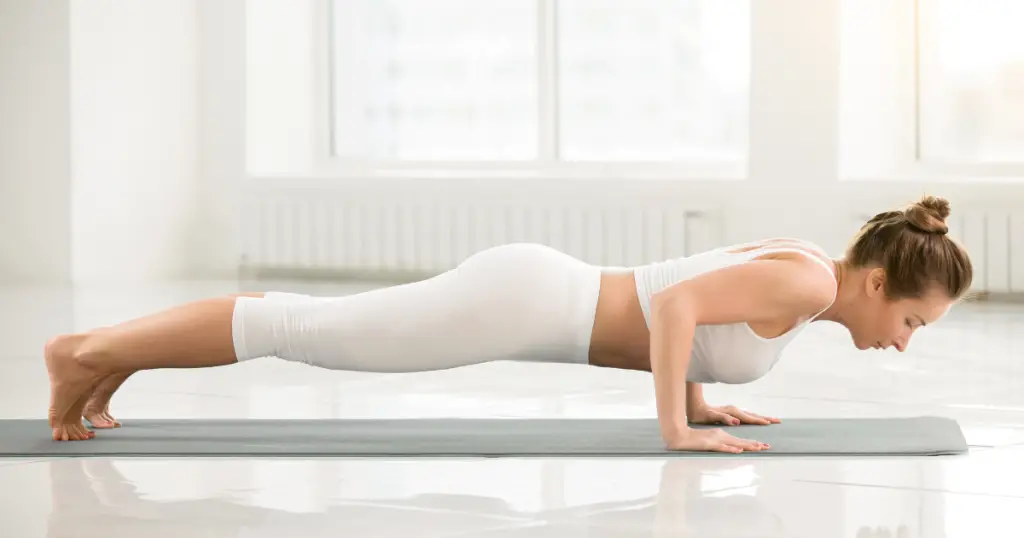
9. Cobra Pose With Arms Up
You will find many back-bending poses if you research the best yoga poses for core strength online. Personally, backbends would not be my first choice to improve your core strength, although I love backends! I love them for their energizing, heart-opening benefits.
On the other hand, cobra with arms up variation requires core strength and back flexibility.
Cobra with arms up variation is an excellent yoga pose for developing a strong core. This pose engages the abdominal muscles, including the rectus abdominis and obliques, while strengthening the back and improving posture. By lifting the chest and extending the arms upwards, cobra with arms up variation promotes both strength and flexibility, making it a compelling choice for enhancing core stability and overall body alignment.
10. L-Sit
Last but not least, the L-Sit. Oh, my! I still cannot do the L-Sit, but I am working on it!
The l-sit is among the best yoga poses for developing a strong core. By actively engaging the abdominal muscles and stabilizing the body, the l-sit challenges strength and balance. This pose targets the deep core muscles, including the rectus abdominis, obliques, and transverse abdominis, promoting overall core strength and stability. Incorporating the l-sit into a regular yoga practice can improve posture, enhance athletic performance, and increase abdominal strength.
My weakness in performing the L-Sit is still my hip-flexor strength. I try to do these Crazy Effective Hip Flexor Strengthening Exercises regularly.
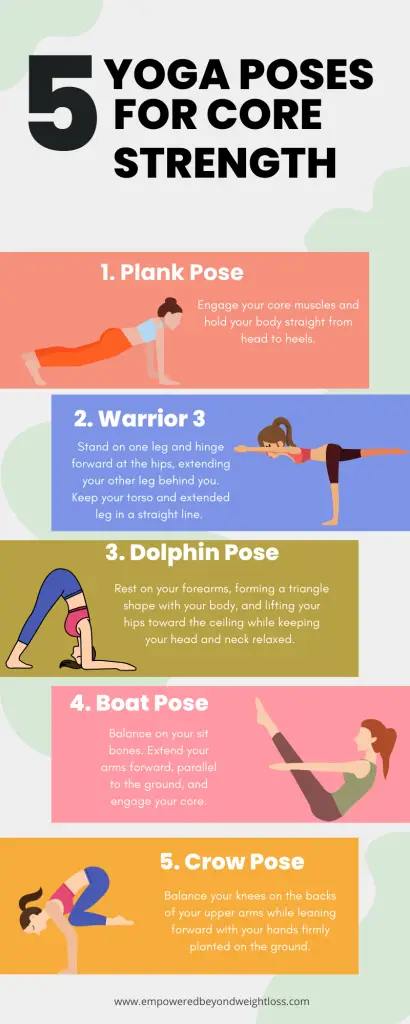
Tips for Practicing Yoga for a Strong Core
The best yoga for a strong core is a yoga that you practice. That’s why I wanted to share some essential tips for success.
Consistency is key
Consistency is the linchpin to success when practicing yoga for core strength. Yoga is a discipline that thrives on gradual progress, and by maintaining a regular practice routine, individuals can cultivate the deep, enduring strength of their core muscles. Over time, consistent practice allows for a deeper connection between mind and body, honing the awareness of the core’s engagement and alignment in various poses. The core muscles adapt and strengthen progressively, providing better support for the spine, improved posture, and enhanced balance. Moreover, the mental benefits of a consistent yoga practice, such as reduced stress and increased focus, further underscore the importance of regularity. Making yoga an integral part of one’s lifestyle makes the journey toward a stronger and more stable core achievable and sustainable.
Needing help to stay consistent? That’s why I created my 5-Day Yoga Habit Challenge.
Start With Modifications and Progress Gradually
Modifying poses and progressing gradually in yoga is fundamental to success because it ensures safety, promotes mindfulness, and fosters sustainable growth. Everyone has a unique body with varying flexibility, strength, and experience, making it essential to adapt poses to suit one’s current abilities. By doing so, practitioners can prevent injury and avoid pushing themselves too hard, which could deter long-term commitment to yoga. Gradual progression allows the body to adapt over time, steadily building strength, flexibility, and balance while minimizing the risk of strain or overuse. Furthermore, modifying poses and advancing comfortably encourages mindfulness, enabling practitioners to deepen their mind-body connection and develop greater self-awareness. Ultimately, this patient and adaptable approach to yoga ensures physical success and cultivates a deeper appreciation for the practice.
Use props like yoga blocks and a strap. Practice plank pose on your knees, or practice down-dog instead of dolphin pose. There is always a way to modify to suit your needs and goals.
Read How to Use a Yoga Block to Make 10 Common Poses Easier or Harder and
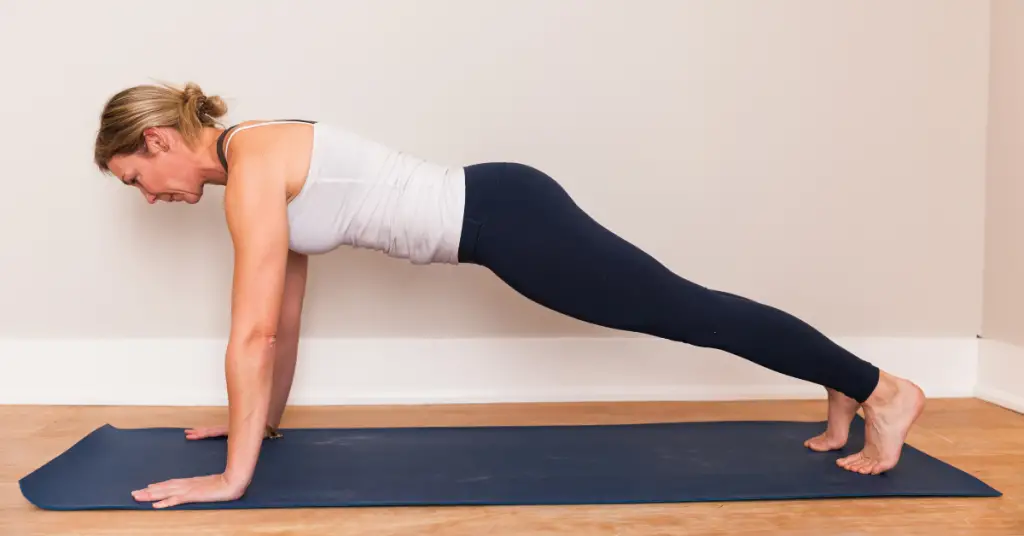
Engage the Core Throughout the Practice
Have you heard the term bandha in yoga?
All three bandhas (Mula Bandha, Uddiyana Bandha, and Jalandhara Bandha) are important components of core engagement in yoga. Depending on the style of yoga and the specific asanas (poses) being practiced, not all bandhas may be engaged simultaneously. Here’s a breakdown of their roles in core engagement:
- Mula Bandha (Root Lock): Mula Bandha involves engaging and lifting the pelvic floor muscles. It plays a significant role in core engagement by providing stability and support to the pelvic region. Mula Bandha is often used in poses that require lower abdominal and pelvic stability, such as balancing poses, seated poses, and inversions.
- Uddiyana Bandha (Abdominal Lock): Uddiyana Bandha involves pulling the abdominal muscles inward and upward toward the ribcage. It’s primarily used during breathing exercises (pranayama) and some advanced asanas. It helps strengthen the core, aids in deep breathing, and contributes to the energetic aspects of yoga practice.
- Jalandhara Bandha (Throat Lock): Jalandhara Bandha involves tucking the chin down and pressing it lightly against the chest. It’s mainly used during specific breathing techniques and advanced yoga practices to redirect energy flow and facilitate control over the throat and thyroid gland.
In many yoga poses, core engagement primarily relies on Mula Bandha and, to some extent, Uddiyana Bandha. These bandhas help maintain stability, alignment, and balance. However, not all yoga styles or poses require using all three bandhas simultaneously.
For beginners, it is common to focus on Mula Bandha and gradually incorporate Uddiyana Bandha as they become more experienced. Jalandhara Bandha is typically reserved for more advanced practices and specific breath retention techniques.
In Summary
In conclusion, the best yoga for core strength involves consistency, proper technique, and various yoga poses for core strength. The best yoga poses for core strength target the abdominal muscles, improve stability, and enhance overall body balance. Regular yoga strengthens the core, enhances flexibility, reduces stress, and promotes mental well-being. Incorporating these yoga poses into your routine can bring significant physical and mental benefits. Take the next step towards a stronger core by joining my 5-Day Yoga Habit Challenge. Start your journey towards a healthier body and mind today.
